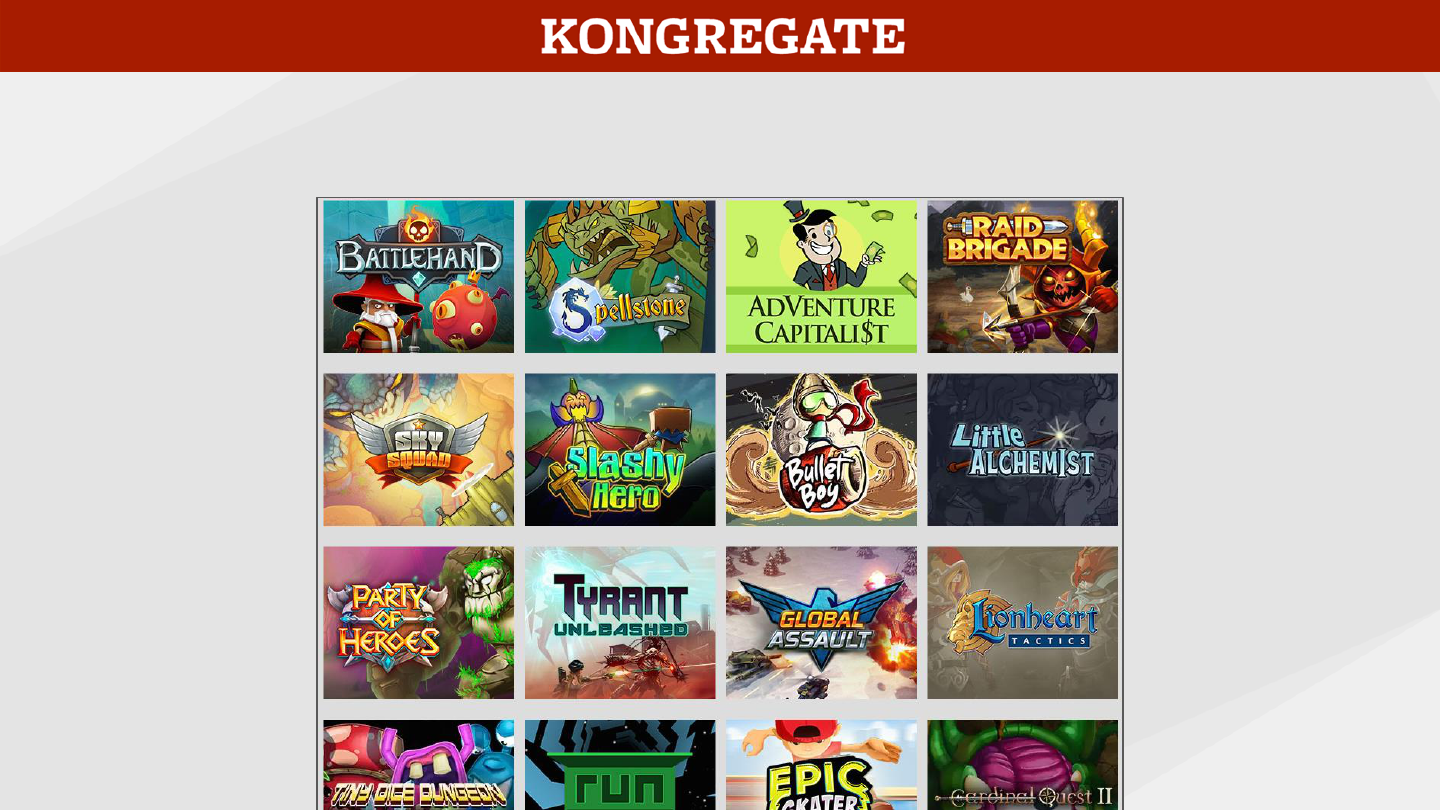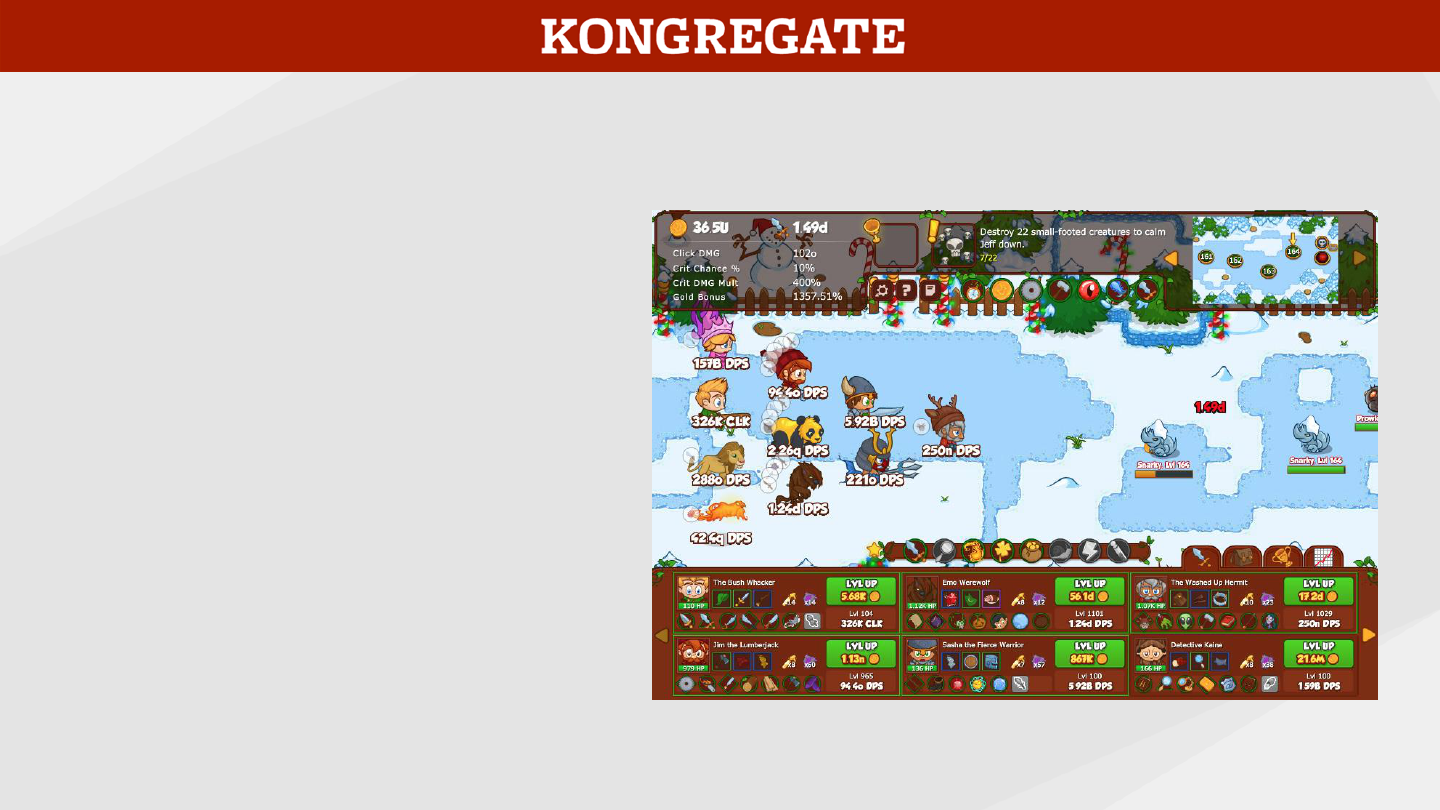
Quest for Progress
The Math and Design of Idle Games
Anthony Pecorella
Kongregate.com

Who Am I?
• At Kongregate for 7 years,
directing our browser-based
F2P virtual goods business
• Producer for
AdVenture Capitalist mobile
• Also an indie designer,
cofounder of Level Up Labs

Kongregate.com

Kongregate Publishing

Opening Disclaimers
• This is a design and math talk, not a data and
monetization talk
• There is some calculus, but you don’t need to
remember how it works
• If you don’t like graphs, numbers, and formulas
you’re not going to like this talk

Interactive Charts and Sheets
• All of the graphs generated in this talk come from
sheets that are publicly available as both Google
Sheets and .xls files
• You can access these sheets here:
http://kon.gg/idle-math-spreadsheets

Genre Terminology
• Incremental Games
– A game in which the primary goal is to continually increase
a number
– Often grows in complexity over time
• When the scope of a game change substantially it is can referred
to as an “unfolding game”
• Examples: A Dark Room, Candy Box, Frog Fractions

Genre Terminology
• Idle Games
– Subset of Incrementals
– Progress or income is made without player interaction
– Player choices impact growth rates
– It is expected that players leave the game alone regularly
– Typically do not have an “end”

Genre Terminology
• Clicker Games
– Emphasis on clicking or tapping to progress
– Ex. Feed Your Monster, Football Clicker
– Can, but does not necessarily, have idle elements
• Clicker Heroes is an “idle clicker”
– Physicality of the game can be fun but also tiring

Essential Reading
• Cookie Clicker-likes
– AdVenture Capitalist
– Realm Grinder
– Pocket Politics

Essential Reading
• Clicker Heroes-likes
– Tap Titans
– Crusaders of the
Lost Idols

Essential Reading
• Assorted Others
– Number (Tyler Glaiel)
– Swarm Simulator
– Sandcastle Builder
• The Dwarf Fortress of
idle games

Terminology
• Primary Currency
– The central number that is being incremented and typically
used to purchase most moment-to-moment improvements

Terminology
• Generator
– The buildings, investments, characters, etc. that a player
amasses
– They automatically generate Primary Currency (or
Exchange Currency) over time
– Costs grow magnitude faster than value

Terminology
• Primary Exchange Currency
– A special case worth mentioning, in some cases generators
produce an exchange currency
– The most common example is damage / DPS in RPG idlers
• Damage is not the primary currency but is tied directly to it
• Gives designer a little more control over primary currency
accumulation since you can gate or buff conversion at certain
points in the progression

Terminology
• Multiplier
– Typically a fixed multiple on a generator, or set of
generators, in terms of production value or speed
– These help offset cost growth speed
– Provide bumps and local victories

Terminology
• Multiplier
– More complex ones might have dependencies on:
• Its target (e.g. this generator count)
• Other generators (e.g. total generator count)
• Meta statistics (e.g. total time played, count of lifetime skills used,
lifetime currency earned, seconds since last reset, etc.)
• External data (e.g. time of day, holidays/events, concurrent player
count, etc.)
– Incentivized ads are often implemented as a multiplier

Terminology
• Active Skill
– Powerful abilities players can initiate
– Typically have a long cooldown (5 minutes – a few hours)
– Increases player agency, letting them burst income or get
over a hump
– In more complex situations, players can strategize around
best selection, order, and timing of skill usage

Terminology
• Prestige
– Player resets game with a bonus to
production
– Similar to the “new game+” concept
• Meta Prestige
– Prestiges can be nested

Terminology
• Prestige Currency
– Provides player with Prestige Currency that controls the
production bonus
• This currency typically grows at a slower order of magnitude than
Primary Currency – we’ll look into examples later
– In some cases this currency can also be spent for boosts (at
the loss of the relative Prestige Currency boost)

Idle Player Motivation Profile
• Quantic Foundry surveyed
players of 3 idle games
• 70% identified as “core
gamers”, 20% as “hardcore”
• Top motivators were
Completion and Power
From Nick Yee’s gamer motivation profiling

Idle Player Motivation Profile
• This can help guide your design process
• Players of this genre want to collection and
complete, and they want to grow in power
– Power growth is central to the genre but you want to make
sure players “feel” that growth
– Can you incorporate collection or completionism into your
idle game design?

Super quick review of exp growth curves
• Costs grow exponentially
cost
next
= cost
base
x (rate
growth
)
owned
• Production grows linearly
prod
total
= prod
base
x n
owned
• Note: x
k
is not exponential growth and will always be
outpaced by k
x
(with k > 1) eventually.

Exponential Growth Rates in AdCap
• For AdCap, here are the values for a few generators:
Lemonade Stand growth with doubling at 25, 50 owned

Exponential Growth Rates in AdCap
• More Lemonade Stand graphs, with 2x at every 100
and each prestige giving a 5x boost

Optimal Decisions
• Due to how costs and value grow, players will
regularly be deciding what to buy next
• We can model optimal choice to see if we
– While players likely won’t optimize perfectly, overall
patterns will be similar for savvy players
– Sometimes tiny generators are optimal but negligible in
impact – players will most-likely ignore these

Optimal Purchase Decisions
• Do you want optimal purchasing to be an interesting
choice for players?
– If so and you see optimal patterns always favoring the
highest tier generator, you may have a balance problem
– If not then you likely have other game elements that are
interesting and don’t need to balance this carefully

Optimal Purchase Decisions

Optimal Purchase Decisions

Total Cost of Bulk Purchases
• Bulk-buying of generators is often a necessary
function, but what is the cost of such a purchase?
• To buy n generators:
– With base price b
– With exponent r
– Owning k already

Total Cost of Bulk Purchases
• What’s the max number of generators you can buy?
– With base price b
– With exponent r
– Owning k already
– Having c currency

Non-Cookie Clicker Growth
• Cookie Clicker set standard for growth patterns of
generators
• Other options exist though and can be explored

Non-Cookie Clicker Growth
• What if generators produced generators?
– Generator 1 produces Primary Currency
– Generator 2 produces Generator 1’s
– Generator 3 produces Generator 2’s
– etc.
• These are actually…

Derivatives
• DERIVATIVES!
• Each parent generator is the
rate of change of the child
– Generator 1 = f(x)
– Generator 2 = f’(x)
– Generator 3 = f’’(x)
– etc.
Derivative Clicker

Educational!
• People don’t even realize they’re working with
derivatives!
• Great way to conceptualize relationship of higher-
order derivatives
– Physics: Location, Speed, Acceleration, Jerk, …?
– Here: Each is just the rate of change of the one above it

Derivative Growth In Action
• But what does this actually look like?

Derivative Growth In Action
• But what does this actually look like?

Derivative Growth In Action
• But what does this actually look like?

Approaching Exponential Growth
• While different in formulation, the growth rate turns
out to be similar
– Let’s assume each parent produces 1 child, and we have 4
tiers
– Tier 4 would be a constant f(x) = 1
– Tier 3 is ∫(1) = x
– Tier 2 is ∫(x) = x
2
/ 2
– Tier 1 is ∫(x
2
/ 2) = x
3
/ 6

Approaching Exponential Growth
– Anyone remember Taylor series?
– The Taylor series expansion of e
x
is…
– As we get more tiers, we approach actual exponential
growth!

Intermission: On Big Numbers
• Think of the biggest number you know of
– googol? = 10
100
– googolplex? = 10
googol
(Special thanks to Eclipse1agg on Reddit)

Intermission: On Big Numbers
• Operator Progression
– a++ = a + 1 (unary increment)
– a + b = a++ (b times)
– a * b = a + a + ... + a (b times)
– a ^ b = a * a * ... * a (b times)
– a ↑↑ b = a ^ a ^ … ^ a (b times)
– a ↑↑↑ b = a ↑↑ a ↑↑ … ↑↑ a (b times)

Intermission: On Big Numbers
• Example Values
– 3++ = 4
– 3 + 4 = 7
– 3 * 4 = 12
– 3 ^ 4 = 81
– 3 ↑↑ 4 = 7,625,597,484,987
– Note: 3 ↑↑ 5 is > googolplex
– 3 ↑↑↑ 4 = ?!?!?!

Intermission: On Big Numbers
• Sample values for ↑↑↑
– 2 ↑↑↑ 2 = 2 ↑↑ 2 = 4 (always!!)
– 2 ↑↑↑ 3 = 256
– 3 ↑↑↑ 2 = 7,625,597,484,987
– 4 ↑↑↑ 2 = a number with over 10
153
digits
– 2 ↑↑↑ 4 = far too big to count digits in scientific notation
– 3 ↑↑↑ 3 = FML

Intermission: On Big Numbers
• Graham’s number!
– G = g
64
– g
1
= 3 ↑↑↑↑ 3
– g
2
= 3 ↑ …{g
1
times}… ↑ 3
– We do know it ends in ...262464195387.
– Used as an upper bound in a mathematical proof

Keeping All Generators Relevant
• A common problem is keeping smaller generators
relevant to the player
– Production is generally dwarfed, especially with
exponential growth of cost
– This is an even bigger problem for derivative-style growth

Keeping All Generators Relevant
• Do you care if lower generators are relevant for your
players?
– It adds a layer of complexity to both game balance and
player understanding and may not be necessary depending
on your target audience, play style goals, and other
elements
– If however you do care…

Keeping All Generators Relevant
• Possible Solutions
– Aggressive multipliers to force relevance
– Base bonuses on ownership of these generators
• Even if direct generation is low, impact of purchasing is high
– Example: Newspapers in AdVenture Capitalist multiply other
investments
• Note: track purchased and earned generators separately in
derivative growth systems (Derivative Clicker example)

Keeping All Generators Relevant
• Possible Solutions
– Tie prestige currency to ownership
• Clicker Heroes gives one prestige currency for every 2000
generators owned
– Use ownership multipliers to compound on cheaper
generators
• Clicker Heroes gives a x4 bonus for every 25 of a generator

Prestige Cycles
• When will players prestige?
– Common rule of thumb is to reset when you would gain
somewhere in the range of +50% to +200% prestige
currency
• What formula will you use for prestige currency?
– Take a log or a fractional exponent (like square root) to
scale back growth rates
– Ensure that players reach a valuable prestige point
regularly

Prestige Cycles
• What does the next cycle look like for players?
– Will their progress through the early part be quick? This is
an important feeling of growth of power.
– Will they be able to get noticeably farther than last time?
• Do you want the cycles to get faster, slower, or vary?
– Faster: players will shift prestige point to be a lot higher
– Slower: could get tiresome, must have a meta prestige too
– Varied: prestige provides surprises, harder to design

Prestige Cycles
• Simple model of a
single generator
– Can estimate player
behavior based on
value of generator
– Multipliers based on
number owned allow
for variable times
between prestiges

Prestige Cycles
• Zooming out we can
see a lot of variation in
time to prestige

Other Growth Patterns
– Combinatorics
• Pizza store game, income based on how many different types of
pizza you can make
•
n
C
r
= n! / (n-r)!r!
• Upgrade to use more ingredients per pizza (r) and have larger
variety of ingredients to use (n)
– Node connections
• City-builder with a prestige to found a new city, trade routes
between all cities [(n)(n-1)/2]

Notable New Genre Additions
• Egg Inc.
– Slick, minimalist visual design
– Egg theme is cute and humorous
– Dual limiters (egg rate and sale rate)
provide for some interesting decisions
over time
– Has a 2 hour limit on offline earning – I
think this was a mistake, I churned out
myself largely because of this

Notable New Genre Additions
• Nonstop Knight
– Clicker Heroes-like-like
– Idle game that looks and feels like a
dungeon crawler
– Armor and hitpoints of hero are
important
– Skills have short cooldowns, playing
more like Diablo skills
– Clever speed-up system to get through
early, trivial content when prestiging

Notable New Genre Additions
• War Tortoise
– Visually very strong
with really cool
visualization of
combat and upgrades
– Player interaction is
powerful and
thankfully requires no
rapid tapping

Notable New Genre Additions
• AbyssRium
– Very pretty, relaxing design
– Milestone multipliers are tied
to buying fish, creates a great
collection system built into
the mechanics

Thank You!
• Check out developers.kongregate.com
• Browser games: apps@kongregate.com
• Mobile games: bd@kongregate.com
• Me: anthony@kongregate.com
• Slides will be available at
developers.kongregate.com/blog
